Accounting Theory & Contemporary Issues: Analysis of Dick Smith Holding Ltd Collapse
VerifiedAdded on 2022/11/13
|10
|2629
|361
AI Summary
This report analyzes the strategic errors, accounting practices, and governance issues that led to the collapse of Dick Smith Holding Ltd. It provides recommendations for businesses to avoid similar failures.
Contribute Materials
Your contribution can guide someone’s learning journey. Share your
documents today.
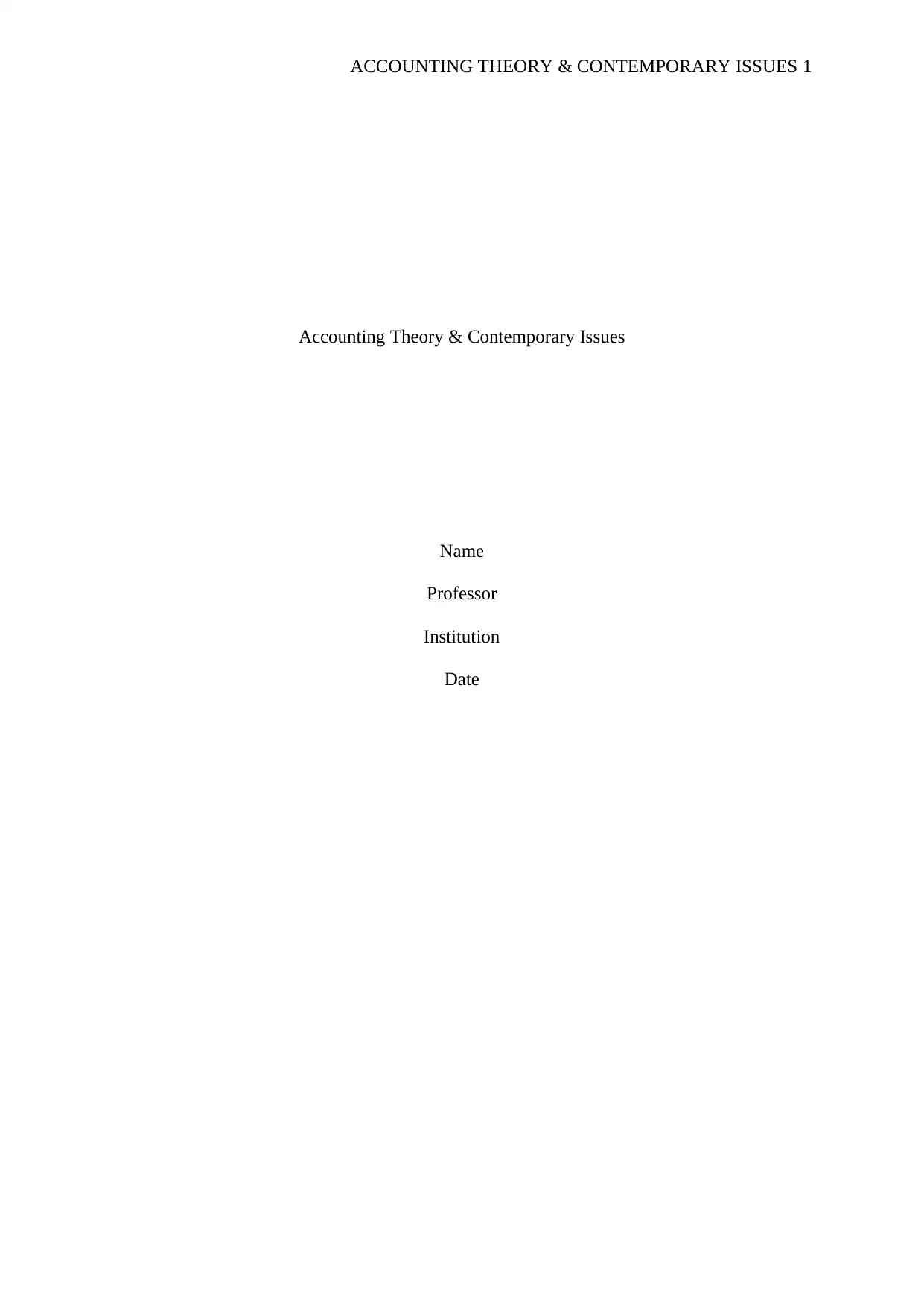
ACCOUNTING THEORY & CONTEMPORARY ISSUES 1
Accounting Theory & Contemporary Issues
Name
Professor
Institution
Date
Accounting Theory & Contemporary Issues
Name
Professor
Institution
Date
Secure Best Marks with AI Grader
Need help grading? Try our AI Grader for instant feedback on your assignments.
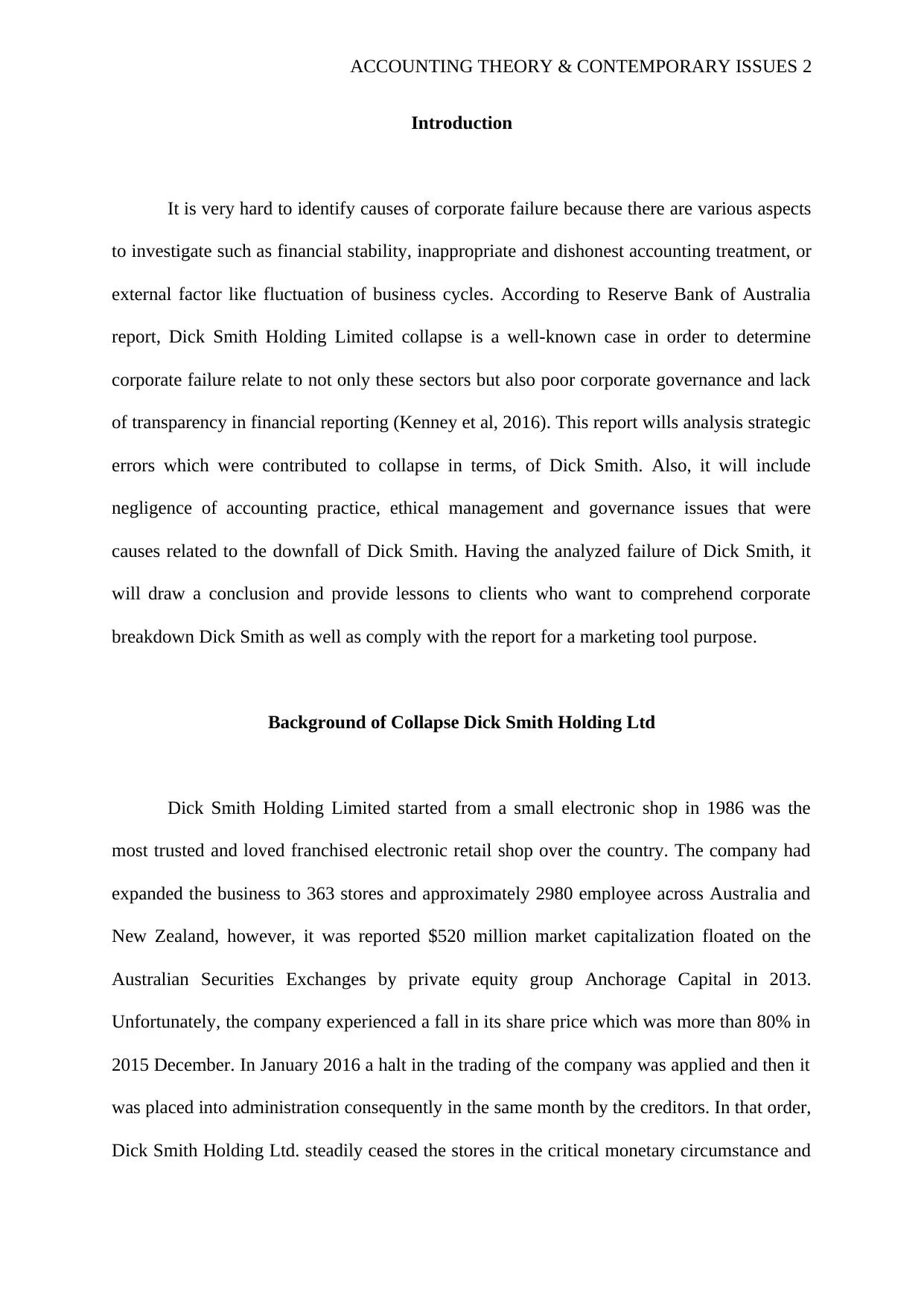
ACCOUNTING THEORY & CONTEMPORARY ISSUES 2
Introduction
It is very hard to identify causes of corporate failure because there are various aspects
to investigate such as financial stability, inappropriate and dishonest accounting treatment, or
external factor like fluctuation of business cycles. According to Reserve Bank of Australia
report, Dick Smith Holding Limited collapse is a well-known case in order to determine
corporate failure relate to not only these sectors but also poor corporate governance and lack
of transparency in financial reporting (Kenney et al, 2016). This report wills analysis strategic
errors which were contributed to collapse in terms, of Dick Smith. Also, it will include
negligence of accounting practice, ethical management and governance issues that were
causes related to the downfall of Dick Smith. Having the analyzed failure of Dick Smith, it
will draw a conclusion and provide lessons to clients who want to comprehend corporate
breakdown Dick Smith as well as comply with the report for a marketing tool purpose.
Background of Collapse Dick Smith Holding Ltd
Dick Smith Holding Limited started from a small electronic shop in 1986 was the
most trusted and loved franchised electronic retail shop over the country. The company had
expanded the business to 363 stores and approximately 2980 employee across Australia and
New Zealand, however, it was reported $520 million market capitalization floated on the
Australian Securities Exchanges by private equity group Anchorage Capital in 2013.
Unfortunately, the company experienced a fall in its share price which was more than 80% in
2015 December. In January 2016 a halt in the trading of the company was applied and then it
was placed into administration consequently in the same month by the creditors. In that order,
Dick Smith Holding Ltd. steadily ceased the stores in the critical monetary circumstance and
Introduction
It is very hard to identify causes of corporate failure because there are various aspects
to investigate such as financial stability, inappropriate and dishonest accounting treatment, or
external factor like fluctuation of business cycles. According to Reserve Bank of Australia
report, Dick Smith Holding Limited collapse is a well-known case in order to determine
corporate failure relate to not only these sectors but also poor corporate governance and lack
of transparency in financial reporting (Kenney et al, 2016). This report wills analysis strategic
errors which were contributed to collapse in terms, of Dick Smith. Also, it will include
negligence of accounting practice, ethical management and governance issues that were
causes related to the downfall of Dick Smith. Having the analyzed failure of Dick Smith, it
will draw a conclusion and provide lessons to clients who want to comprehend corporate
breakdown Dick Smith as well as comply with the report for a marketing tool purpose.
Background of Collapse Dick Smith Holding Ltd
Dick Smith Holding Limited started from a small electronic shop in 1986 was the
most trusted and loved franchised electronic retail shop over the country. The company had
expanded the business to 363 stores and approximately 2980 employee across Australia and
New Zealand, however, it was reported $520 million market capitalization floated on the
Australian Securities Exchanges by private equity group Anchorage Capital in 2013.
Unfortunately, the company experienced a fall in its share price which was more than 80% in
2015 December. In January 2016 a halt in the trading of the company was applied and then it
was placed into administration consequently in the same month by the creditors. In that order,
Dick Smith Holding Ltd. steadily ceased the stores in the critical monetary circumstance and
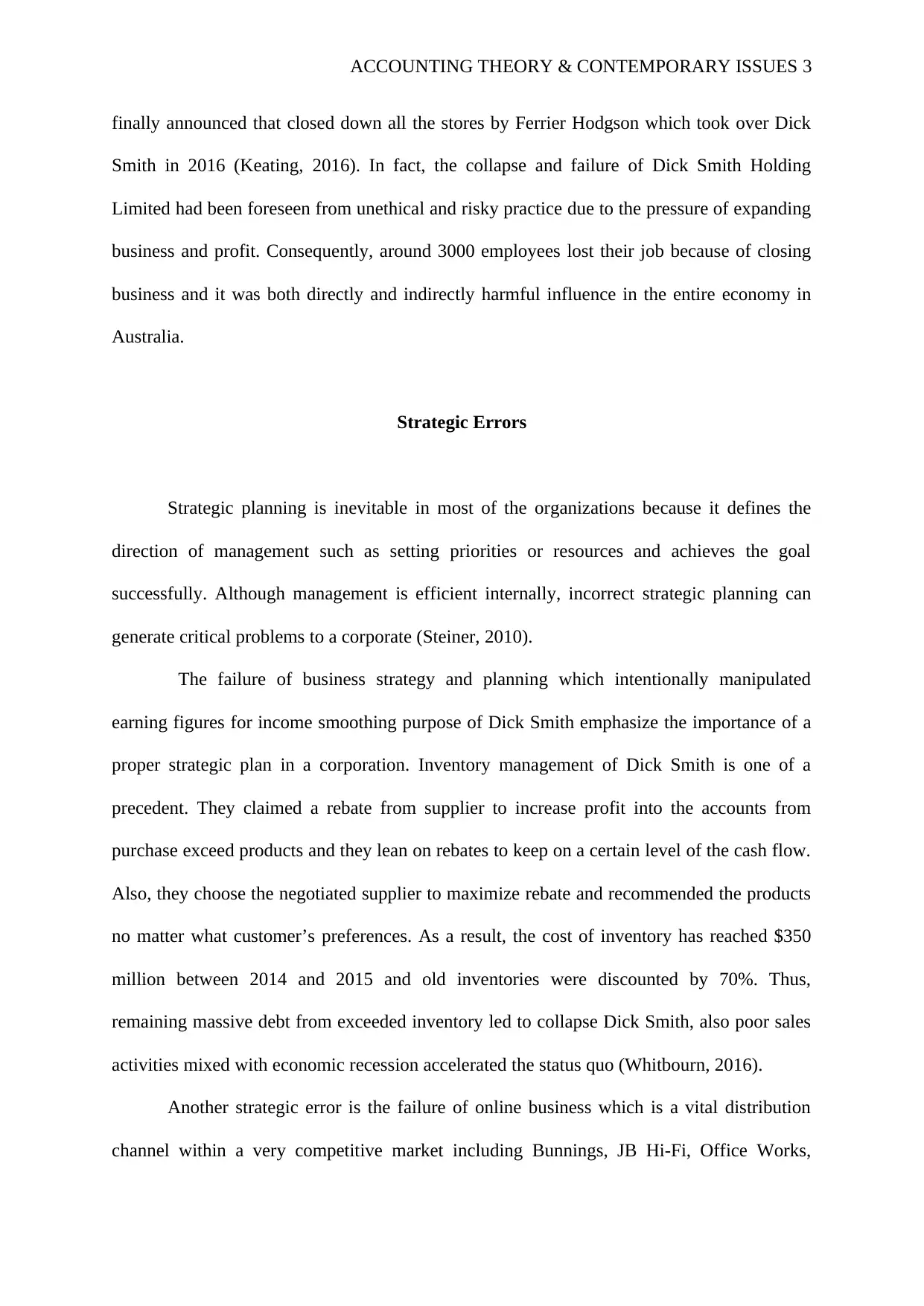
ACCOUNTING THEORY & CONTEMPORARY ISSUES 3
finally announced that closed down all the stores by Ferrier Hodgson which took over Dick
Smith in 2016 (Keating, 2016). In fact, the collapse and failure of Dick Smith Holding
Limited had been foreseen from unethical and risky practice due to the pressure of expanding
business and profit. Consequently, around 3000 employees lost their job because of closing
business and it was both directly and indirectly harmful influence in the entire economy in
Australia.
Strategic Errors
Strategic planning is inevitable in most of the organizations because it defines the
direction of management such as setting priorities or resources and achieves the goal
successfully. Although management is efficient internally, incorrect strategic planning can
generate critical problems to a corporate (Steiner, 2010).
The failure of business strategy and planning which intentionally manipulated
earning figures for income smoothing purpose of Dick Smith emphasize the importance of a
proper strategic plan in a corporation. Inventory management of Dick Smith is one of a
precedent. They claimed a rebate from supplier to increase profit into the accounts from
purchase exceed products and they lean on rebates to keep on a certain level of the cash flow.
Also, they choose the negotiated supplier to maximize rebate and recommended the products
no matter what customer’s preferences. As a result, the cost of inventory has reached $350
million between 2014 and 2015 and old inventories were discounted by 70%. Thus,
remaining massive debt from exceeded inventory led to collapse Dick Smith, also poor sales
activities mixed with economic recession accelerated the status quo (Whitbourn, 2016).
Another strategic error is the failure of online business which is a vital distribution
channel within a very competitive market including Bunnings, JB Hi-Fi, Office Works,
finally announced that closed down all the stores by Ferrier Hodgson which took over Dick
Smith in 2016 (Keating, 2016). In fact, the collapse and failure of Dick Smith Holding
Limited had been foreseen from unethical and risky practice due to the pressure of expanding
business and profit. Consequently, around 3000 employees lost their job because of closing
business and it was both directly and indirectly harmful influence in the entire economy in
Australia.
Strategic Errors
Strategic planning is inevitable in most of the organizations because it defines the
direction of management such as setting priorities or resources and achieves the goal
successfully. Although management is efficient internally, incorrect strategic planning can
generate critical problems to a corporate (Steiner, 2010).
The failure of business strategy and planning which intentionally manipulated
earning figures for income smoothing purpose of Dick Smith emphasize the importance of a
proper strategic plan in a corporation. Inventory management of Dick Smith is one of a
precedent. They claimed a rebate from supplier to increase profit into the accounts from
purchase exceed products and they lean on rebates to keep on a certain level of the cash flow.
Also, they choose the negotiated supplier to maximize rebate and recommended the products
no matter what customer’s preferences. As a result, the cost of inventory has reached $350
million between 2014 and 2015 and old inventories were discounted by 70%. Thus,
remaining massive debt from exceeded inventory led to collapse Dick Smith, also poor sales
activities mixed with economic recession accelerated the status quo (Whitbourn, 2016).
Another strategic error is the failure of online business which is a vital distribution
channel within a very competitive market including Bunnings, JB Hi-Fi, Office Works,
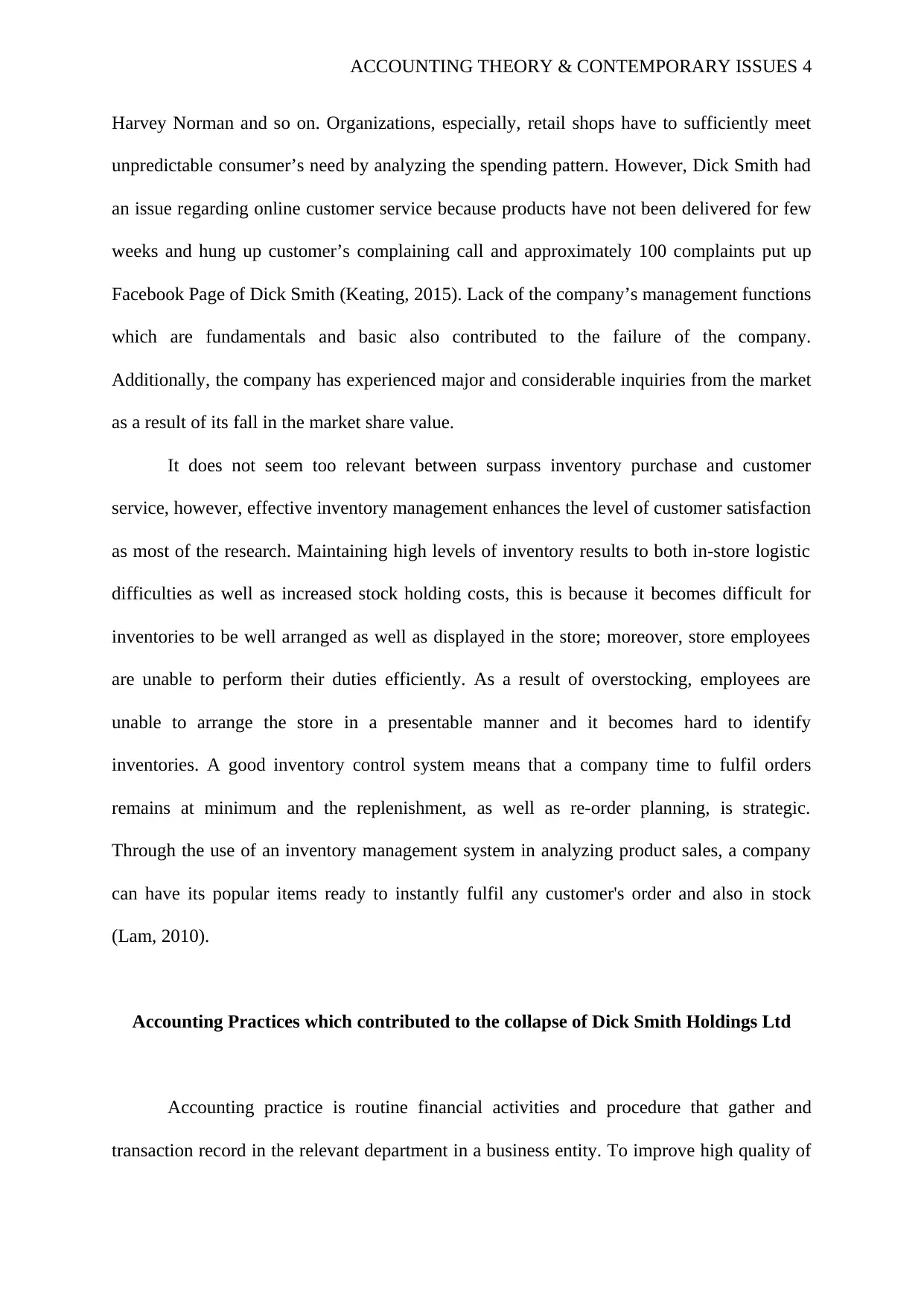
ACCOUNTING THEORY & CONTEMPORARY ISSUES 4
Harvey Norman and so on. Organizations, especially, retail shops have to sufficiently meet
unpredictable consumer’s need by analyzing the spending pattern. However, Dick Smith had
an issue regarding online customer service because products have not been delivered for few
weeks and hung up customer’s complaining call and approximately 100 complaints put up
Facebook Page of Dick Smith (Keating, 2015). Lack of the company’s management functions
which are fundamentals and basic also contributed to the failure of the company.
Additionally, the company has experienced major and considerable inquiries from the market
as a result of its fall in the market share value.
It does not seem too relevant between surpass inventory purchase and customer
service, however, effective inventory management enhances the level of customer satisfaction
as most of the research. Maintaining high levels of inventory results to both in-store logistic
difficulties as well as increased stock holding costs, this is because it becomes difficult for
inventories to be well arranged as well as displayed in the store; moreover, store employees
are unable to perform their duties efficiently. As a result of overstocking, employees are
unable to arrange the store in a presentable manner and it becomes hard to identify
inventories. A good inventory control system means that a company time to fulfil orders
remains at minimum and the replenishment, as well as re-order planning, is strategic.
Through the use of an inventory management system in analyzing product sales, a company
can have its popular items ready to instantly fulfil any customer's order and also in stock
(Lam, 2010).
Accounting Practices which contributed to the collapse of Dick Smith Holdings Ltd
Accounting practice is routine financial activities and procedure that gather and
transaction record in the relevant department in a business entity. To improve high quality of
Harvey Norman and so on. Organizations, especially, retail shops have to sufficiently meet
unpredictable consumer’s need by analyzing the spending pattern. However, Dick Smith had
an issue regarding online customer service because products have not been delivered for few
weeks and hung up customer’s complaining call and approximately 100 complaints put up
Facebook Page of Dick Smith (Keating, 2015). Lack of the company’s management functions
which are fundamentals and basic also contributed to the failure of the company.
Additionally, the company has experienced major and considerable inquiries from the market
as a result of its fall in the market share value.
It does not seem too relevant between surpass inventory purchase and customer
service, however, effective inventory management enhances the level of customer satisfaction
as most of the research. Maintaining high levels of inventory results to both in-store logistic
difficulties as well as increased stock holding costs, this is because it becomes difficult for
inventories to be well arranged as well as displayed in the store; moreover, store employees
are unable to perform their duties efficiently. As a result of overstocking, employees are
unable to arrange the store in a presentable manner and it becomes hard to identify
inventories. A good inventory control system means that a company time to fulfil orders
remains at minimum and the replenishment, as well as re-order planning, is strategic.
Through the use of an inventory management system in analyzing product sales, a company
can have its popular items ready to instantly fulfil any customer's order and also in stock
(Lam, 2010).
Accounting Practices which contributed to the collapse of Dick Smith Holdings Ltd
Accounting practice is routine financial activities and procedure that gather and
transaction record in the relevant department in a business entity. To improve high quality of
Secure Best Marks with AI Grader
Need help grading? Try our AI Grader for instant feedback on your assignments.
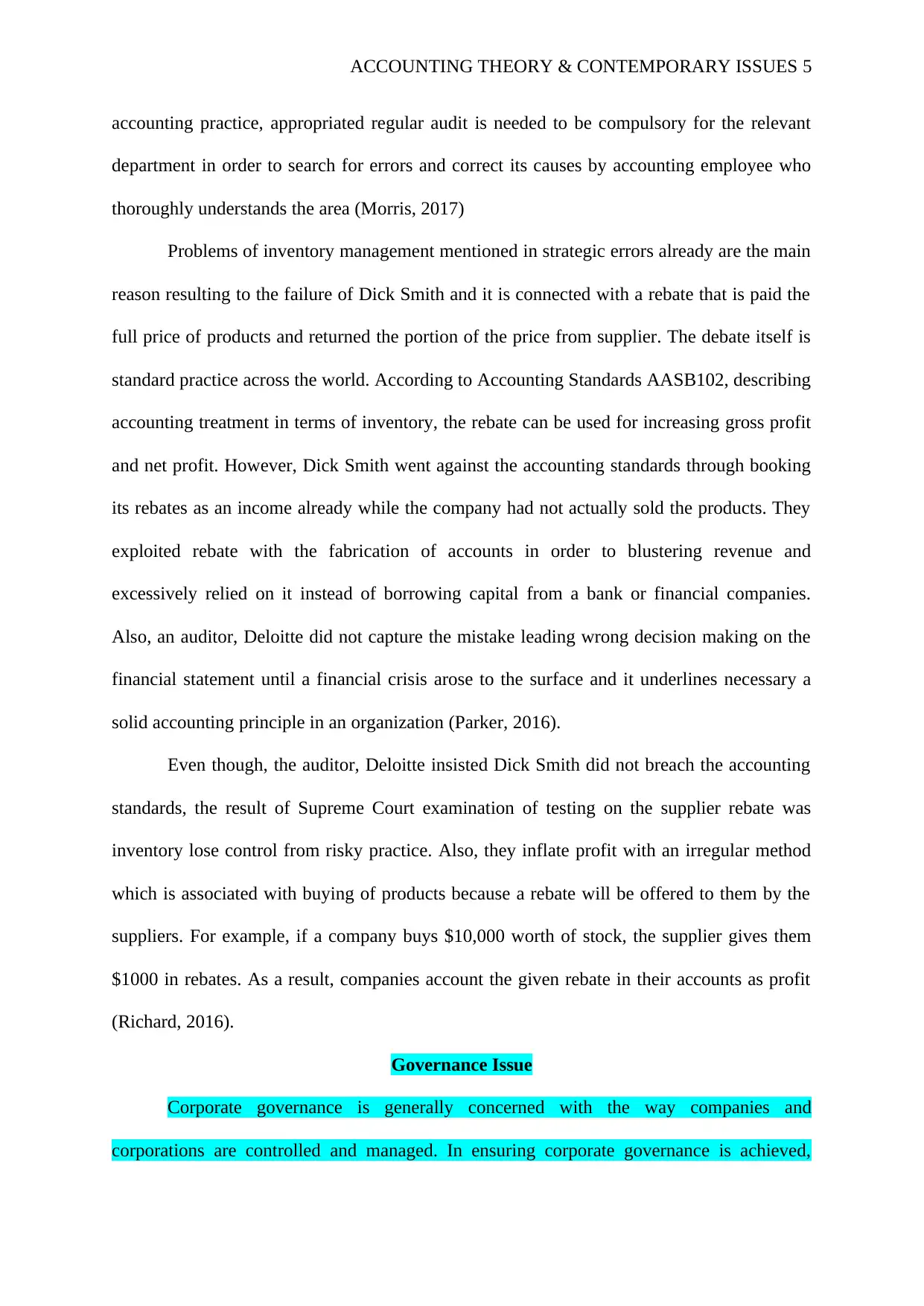
ACCOUNTING THEORY & CONTEMPORARY ISSUES 5
accounting practice, appropriated regular audit is needed to be compulsory for the relevant
department in order to search for errors and correct its causes by accounting employee who
thoroughly understands the area (Morris, 2017)
Problems of inventory management mentioned in strategic errors already are the main
reason resulting to the failure of Dick Smith and it is connected with a rebate that is paid the
full price of products and returned the portion of the price from supplier. The debate itself is
standard practice across the world. According to Accounting Standards AASB102, describing
accounting treatment in terms of inventory, the rebate can be used for increasing gross profit
and net profit. However, Dick Smith went against the accounting standards through booking
its rebates as an income already while the company had not actually sold the products. They
exploited rebate with the fabrication of accounts in order to blustering revenue and
excessively relied on it instead of borrowing capital from a bank or financial companies.
Also, an auditor, Deloitte did not capture the mistake leading wrong decision making on the
financial statement until a financial crisis arose to the surface and it underlines necessary a
solid accounting principle in an organization (Parker, 2016).
Even though, the auditor, Deloitte insisted Dick Smith did not breach the accounting
standards, the result of Supreme Court examination of testing on the supplier rebate was
inventory lose control from risky practice. Also, they inflate profit with an irregular method
which is associated with buying of products because a rebate will be offered to them by the
suppliers. For example, if a company buys $10,000 worth of stock, the supplier gives them
$1000 in rebates. As a result, companies account the given rebate in their accounts as profit
(Richard, 2016).
Governance Issue
Corporate governance is generally concerned with the way companies and
corporations are controlled and managed. In ensuring corporate governance is achieved,
accounting practice, appropriated regular audit is needed to be compulsory for the relevant
department in order to search for errors and correct its causes by accounting employee who
thoroughly understands the area (Morris, 2017)
Problems of inventory management mentioned in strategic errors already are the main
reason resulting to the failure of Dick Smith and it is connected with a rebate that is paid the
full price of products and returned the portion of the price from supplier. The debate itself is
standard practice across the world. According to Accounting Standards AASB102, describing
accounting treatment in terms of inventory, the rebate can be used for increasing gross profit
and net profit. However, Dick Smith went against the accounting standards through booking
its rebates as an income already while the company had not actually sold the products. They
exploited rebate with the fabrication of accounts in order to blustering revenue and
excessively relied on it instead of borrowing capital from a bank or financial companies.
Also, an auditor, Deloitte did not capture the mistake leading wrong decision making on the
financial statement until a financial crisis arose to the surface and it underlines necessary a
solid accounting principle in an organization (Parker, 2016).
Even though, the auditor, Deloitte insisted Dick Smith did not breach the accounting
standards, the result of Supreme Court examination of testing on the supplier rebate was
inventory lose control from risky practice. Also, they inflate profit with an irregular method
which is associated with buying of products because a rebate will be offered to them by the
suppliers. For example, if a company buys $10,000 worth of stock, the supplier gives them
$1000 in rebates. As a result, companies account the given rebate in their accounts as profit
(Richard, 2016).
Governance Issue
Corporate governance is generally concerned with the way companies and
corporations are controlled and managed. In ensuring corporate governance is achieved,
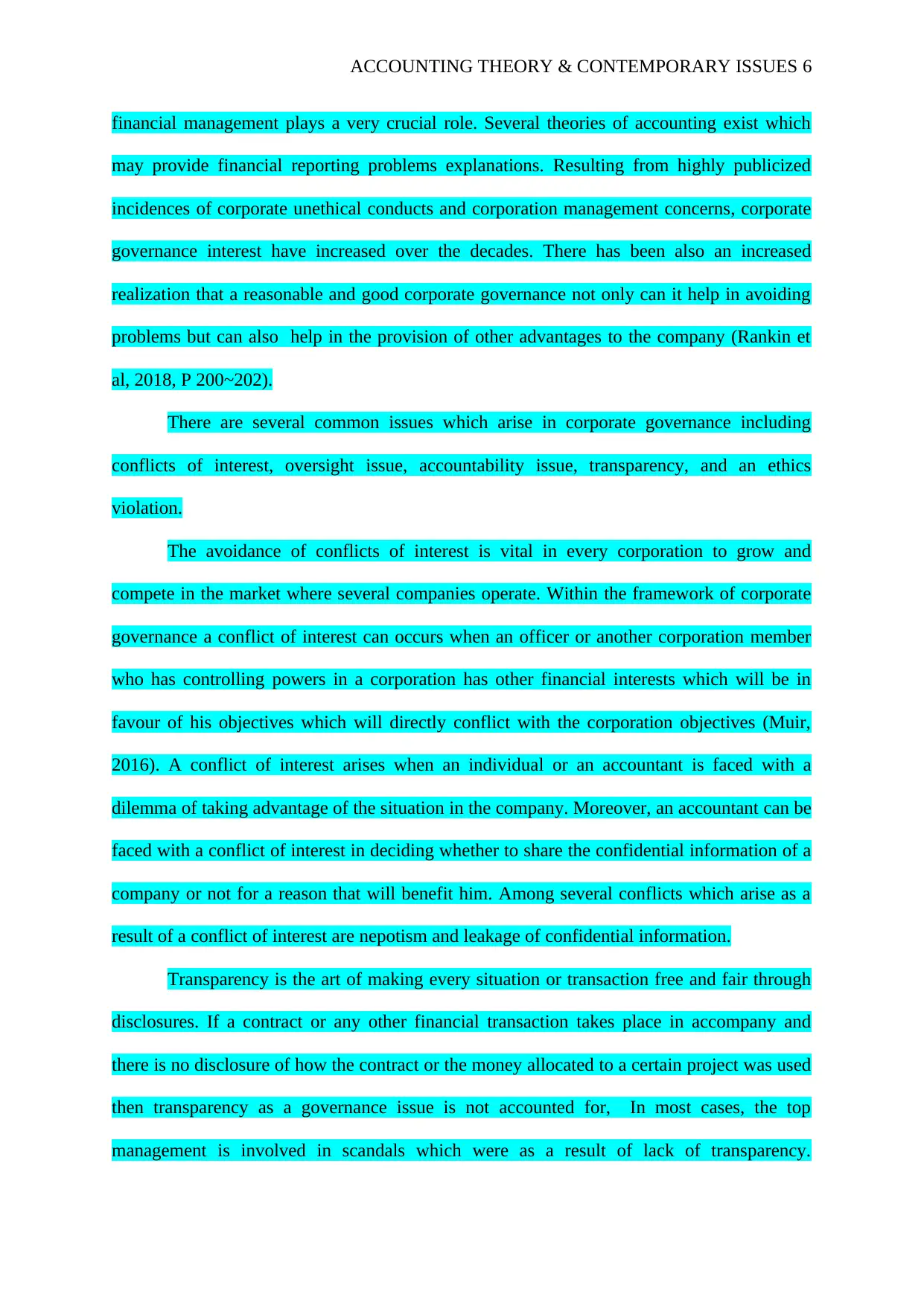
ACCOUNTING THEORY & CONTEMPORARY ISSUES 6
financial management plays a very crucial role. Several theories of accounting exist which
may provide financial reporting problems explanations. Resulting from highly publicized
incidences of corporate unethical conducts and corporation management concerns, corporate
governance interest have increased over the decades. There has been also an increased
realization that a reasonable and good corporate governance not only can it help in avoiding
problems but can also help in the provision of other advantages to the company (Rankin et
al, 2018, P 200~202).
There are several common issues which arise in corporate governance including
conflicts of interest, oversight issue, accountability issue, transparency, and an ethics
violation.
The avoidance of conflicts of interest is vital in every corporation to grow and
compete in the market where several companies operate. Within the framework of corporate
governance a conflict of interest can occurs when an officer or another corporation member
who has controlling powers in a corporation has other financial interests which will be in
favour of his objectives which will directly conflict with the corporation objectives (Muir,
2016). A conflict of interest arises when an individual or an accountant is faced with a
dilemma of taking advantage of the situation in the company. Moreover, an accountant can be
faced with a conflict of interest in deciding whether to share the confidential information of a
company or not for a reason that will benefit him. Among several conflicts which arise as a
result of a conflict of interest are nepotism and leakage of confidential information.
Transparency is the art of making every situation or transaction free and fair through
disclosures. If a contract or any other financial transaction takes place in accompany and
there is no disclosure of how the contract or the money allocated to a certain project was used
then transparency as a governance issue is not accounted for, In most cases, the top
management is involved in scandals which were as a result of lack of transparency.
financial management plays a very crucial role. Several theories of accounting exist which
may provide financial reporting problems explanations. Resulting from highly publicized
incidences of corporate unethical conducts and corporation management concerns, corporate
governance interest have increased over the decades. There has been also an increased
realization that a reasonable and good corporate governance not only can it help in avoiding
problems but can also help in the provision of other advantages to the company (Rankin et
al, 2018, P 200~202).
There are several common issues which arise in corporate governance including
conflicts of interest, oversight issue, accountability issue, transparency, and an ethics
violation.
The avoidance of conflicts of interest is vital in every corporation to grow and
compete in the market where several companies operate. Within the framework of corporate
governance a conflict of interest can occurs when an officer or another corporation member
who has controlling powers in a corporation has other financial interests which will be in
favour of his objectives which will directly conflict with the corporation objectives (Muir,
2016). A conflict of interest arises when an individual or an accountant is faced with a
dilemma of taking advantage of the situation in the company. Moreover, an accountant can be
faced with a conflict of interest in deciding whether to share the confidential information of a
company or not for a reason that will benefit him. Among several conflicts which arise as a
result of a conflict of interest are nepotism and leakage of confidential information.
Transparency is the art of making every situation or transaction free and fair through
disclosures. If a contract or any other financial transaction takes place in accompany and
there is no disclosure of how the contract or the money allocated to a certain project was used
then transparency as a governance issue is not accounted for, In most cases, the top
management is involved in scandals which were as a result of lack of transparency.
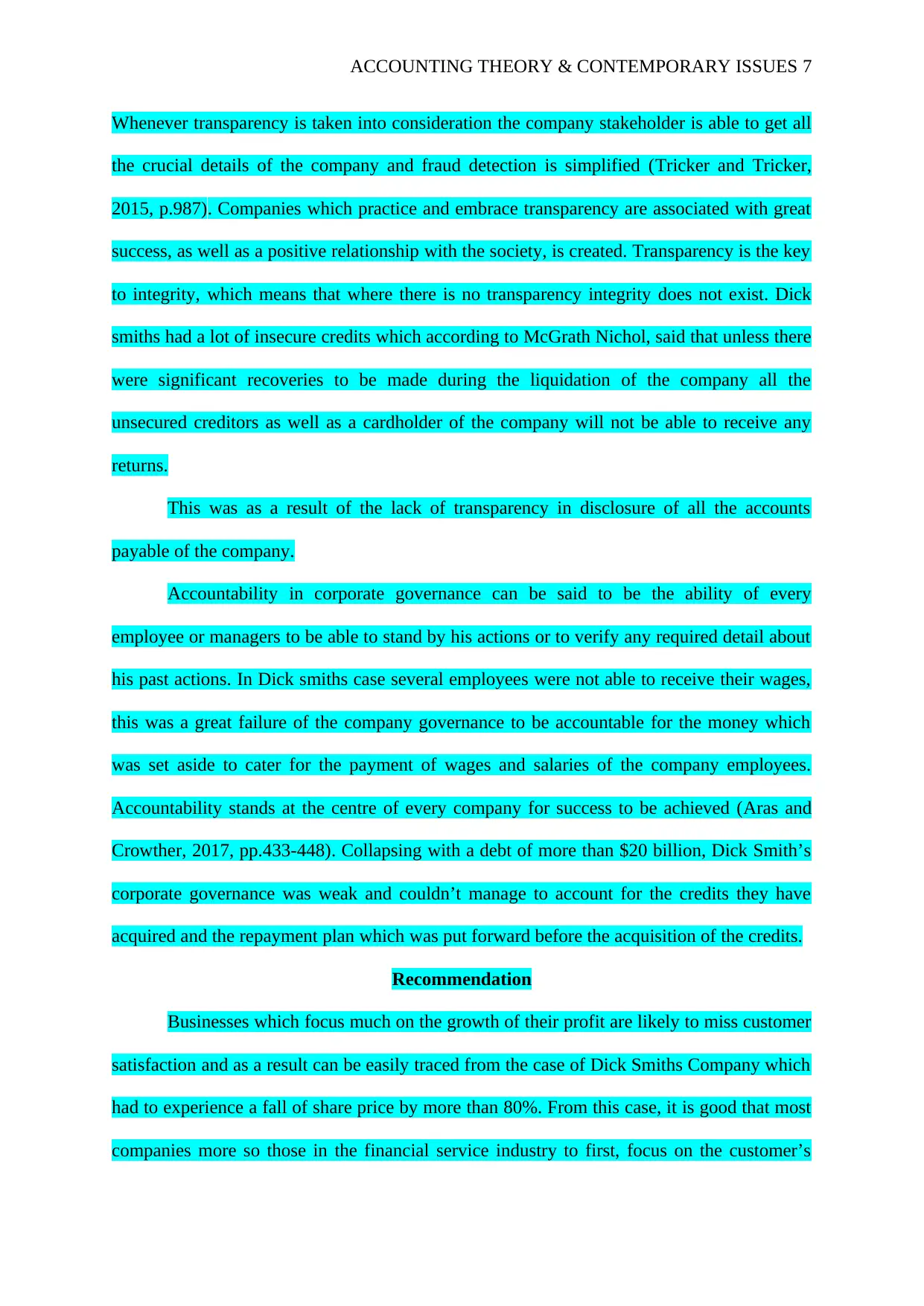
ACCOUNTING THEORY & CONTEMPORARY ISSUES 7
Whenever transparency is taken into consideration the company stakeholder is able to get all
the crucial details of the company and fraud detection is simplified (Tricker and Tricker,
2015, p.987). Companies which practice and embrace transparency are associated with great
success, as well as a positive relationship with the society, is created. Transparency is the key
to integrity, which means that where there is no transparency integrity does not exist. Dick
smiths had a lot of insecure credits which according to McGrath Nichol, said that unless there
were significant recoveries to be made during the liquidation of the company all the
unsecured creditors as well as a cardholder of the company will not be able to receive any
returns.
This was as a result of the lack of transparency in disclosure of all the accounts
payable of the company.
Accountability in corporate governance can be said to be the ability of every
employee or managers to be able to stand by his actions or to verify any required detail about
his past actions. In Dick smiths case several employees were not able to receive their wages,
this was a great failure of the company governance to be accountable for the money which
was set aside to cater for the payment of wages and salaries of the company employees.
Accountability stands at the centre of every company for success to be achieved (Aras and
Crowther, 2017, pp.433-448). Collapsing with a debt of more than $20 billion, Dick Smith’s
corporate governance was weak and couldn’t manage to account for the credits they have
acquired and the repayment plan which was put forward before the acquisition of the credits.
Recommendation
Businesses which focus much on the growth of their profit are likely to miss customer
satisfaction and as a result can be easily traced from the case of Dick Smiths Company which
had to experience a fall of share price by more than 80%. From this case, it is good that most
companies more so those in the financial service industry to first, focus on the customer’s
Whenever transparency is taken into consideration the company stakeholder is able to get all
the crucial details of the company and fraud detection is simplified (Tricker and Tricker,
2015, p.987). Companies which practice and embrace transparency are associated with great
success, as well as a positive relationship with the society, is created. Transparency is the key
to integrity, which means that where there is no transparency integrity does not exist. Dick
smiths had a lot of insecure credits which according to McGrath Nichol, said that unless there
were significant recoveries to be made during the liquidation of the company all the
unsecured creditors as well as a cardholder of the company will not be able to receive any
returns.
This was as a result of the lack of transparency in disclosure of all the accounts
payable of the company.
Accountability in corporate governance can be said to be the ability of every
employee or managers to be able to stand by his actions or to verify any required detail about
his past actions. In Dick smiths case several employees were not able to receive their wages,
this was a great failure of the company governance to be accountable for the money which
was set aside to cater for the payment of wages and salaries of the company employees.
Accountability stands at the centre of every company for success to be achieved (Aras and
Crowther, 2017, pp.433-448). Collapsing with a debt of more than $20 billion, Dick Smith’s
corporate governance was weak and couldn’t manage to account for the credits they have
acquired and the repayment plan which was put forward before the acquisition of the credits.
Recommendation
Businesses which focus much on the growth of their profit are likely to miss customer
satisfaction and as a result can be easily traced from the case of Dick Smiths Company which
had to experience a fall of share price by more than 80%. From this case, it is good that most
companies more so those in the financial service industry to first, focus on the customer’s
Paraphrase This Document
Need a fresh take? Get an instant paraphrase of this document with our AI Paraphraser
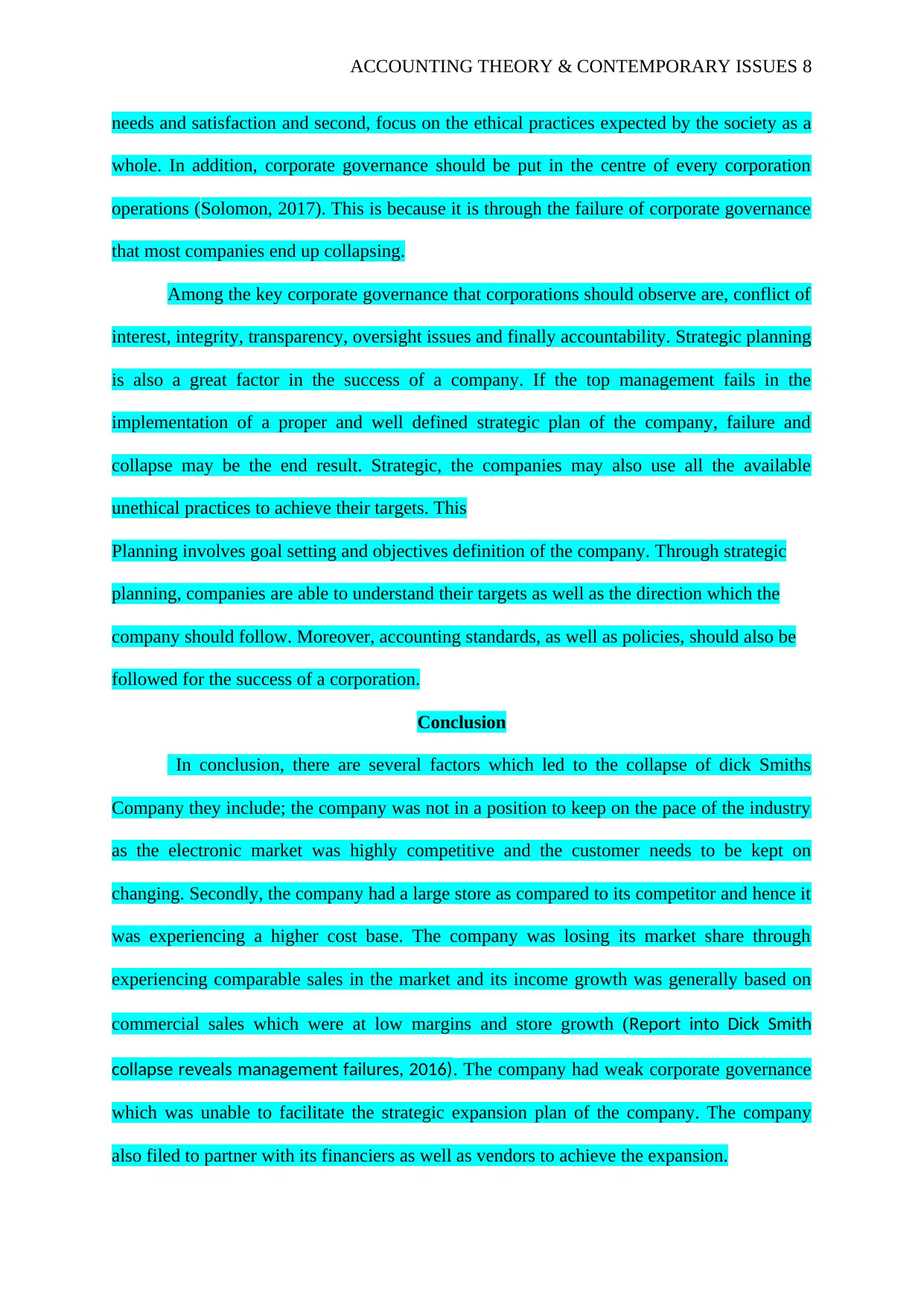
ACCOUNTING THEORY & CONTEMPORARY ISSUES 8
needs and satisfaction and second, focus on the ethical practices expected by the society as a
whole. In addition, corporate governance should be put in the centre of every corporation
operations (Solomon, 2017). This is because it is through the failure of corporate governance
that most companies end up collapsing.
Among the key corporate governance that corporations should observe are, conflict of
interest, integrity, transparency, oversight issues and finally accountability. Strategic planning
is also a great factor in the success of a company. If the top management fails in the
implementation of a proper and well defined strategic plan of the company, failure and
collapse may be the end result. Strategic, the companies may also use all the available
unethical practices to achieve their targets. This
Planning involves goal setting and objectives definition of the company. Through strategic
planning, companies are able to understand their targets as well as the direction which the
company should follow. Moreover, accounting standards, as well as policies, should also be
followed for the success of a corporation.
Conclusion
In conclusion, there are several factors which led to the collapse of dick Smiths
Company they include; the company was not in a position to keep on the pace of the industry
as the electronic market was highly competitive and the customer needs to be kept on
changing. Secondly, the company had a large store as compared to its competitor and hence it
was experiencing a higher cost base. The company was losing its market share through
experiencing comparable sales in the market and its income growth was generally based on
commercial sales which were at low margins and store growth (Report into Dick Smith
collapse reveals management failures, 2016). The company had weak corporate governance
which was unable to facilitate the strategic expansion plan of the company. The company
also filed to partner with its financiers as well as vendors to achieve the expansion.
needs and satisfaction and second, focus on the ethical practices expected by the society as a
whole. In addition, corporate governance should be put in the centre of every corporation
operations (Solomon, 2017). This is because it is through the failure of corporate governance
that most companies end up collapsing.
Among the key corporate governance that corporations should observe are, conflict of
interest, integrity, transparency, oversight issues and finally accountability. Strategic planning
is also a great factor in the success of a company. If the top management fails in the
implementation of a proper and well defined strategic plan of the company, failure and
collapse may be the end result. Strategic, the companies may also use all the available
unethical practices to achieve their targets. This
Planning involves goal setting and objectives definition of the company. Through strategic
planning, companies are able to understand their targets as well as the direction which the
company should follow. Moreover, accounting standards, as well as policies, should also be
followed for the success of a corporation.
Conclusion
In conclusion, there are several factors which led to the collapse of dick Smiths
Company they include; the company was not in a position to keep on the pace of the industry
as the electronic market was highly competitive and the customer needs to be kept on
changing. Secondly, the company had a large store as compared to its competitor and hence it
was experiencing a higher cost base. The company was losing its market share through
experiencing comparable sales in the market and its income growth was generally based on
commercial sales which were at low margins and store growth (Report into Dick Smith
collapse reveals management failures, 2016). The company had weak corporate governance
which was unable to facilitate the strategic expansion plan of the company. The company
also filed to partner with its financiers as well as vendors to achieve the expansion.
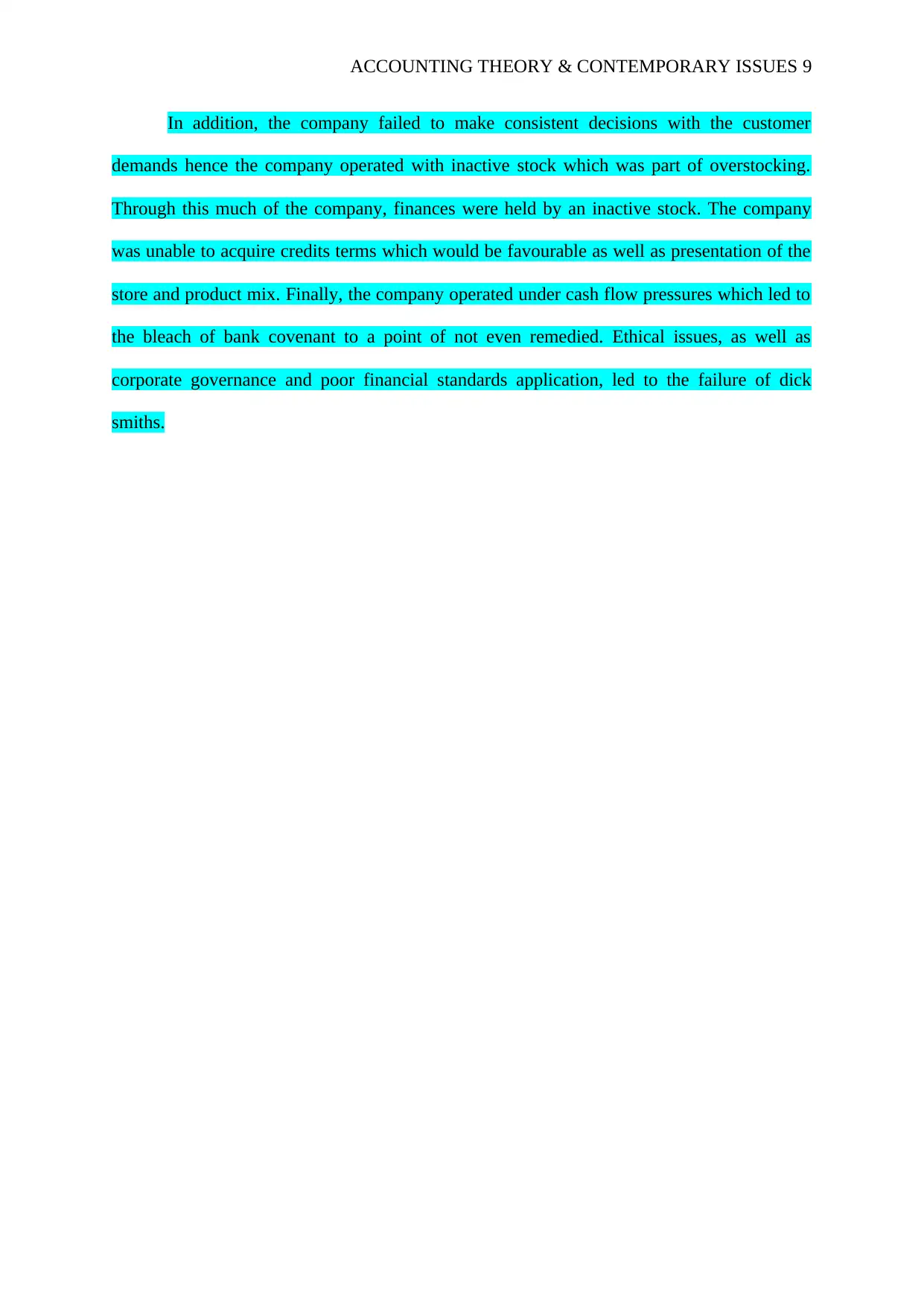
ACCOUNTING THEORY & CONTEMPORARY ISSUES 9
In addition, the company failed to make consistent decisions with the customer
demands hence the company operated with inactive stock which was part of overstocking.
Through this much of the company, finances were held by an inactive stock. The company
was unable to acquire credits terms which would be favourable as well as presentation of the
store and product mix. Finally, the company operated under cash flow pressures which led to
the bleach of bank covenant to a point of not even remedied. Ethical issues, as well as
corporate governance and poor financial standards application, led to the failure of dick
smiths.
In addition, the company failed to make consistent decisions with the customer
demands hence the company operated with inactive stock which was part of overstocking.
Through this much of the company, finances were held by an inactive stock. The company
was unable to acquire credits terms which would be favourable as well as presentation of the
store and product mix. Finally, the company operated under cash flow pressures which led to
the bleach of bank covenant to a point of not even remedied. Ethical issues, as well as
corporate governance and poor financial standards application, led to the failure of dick
smiths.
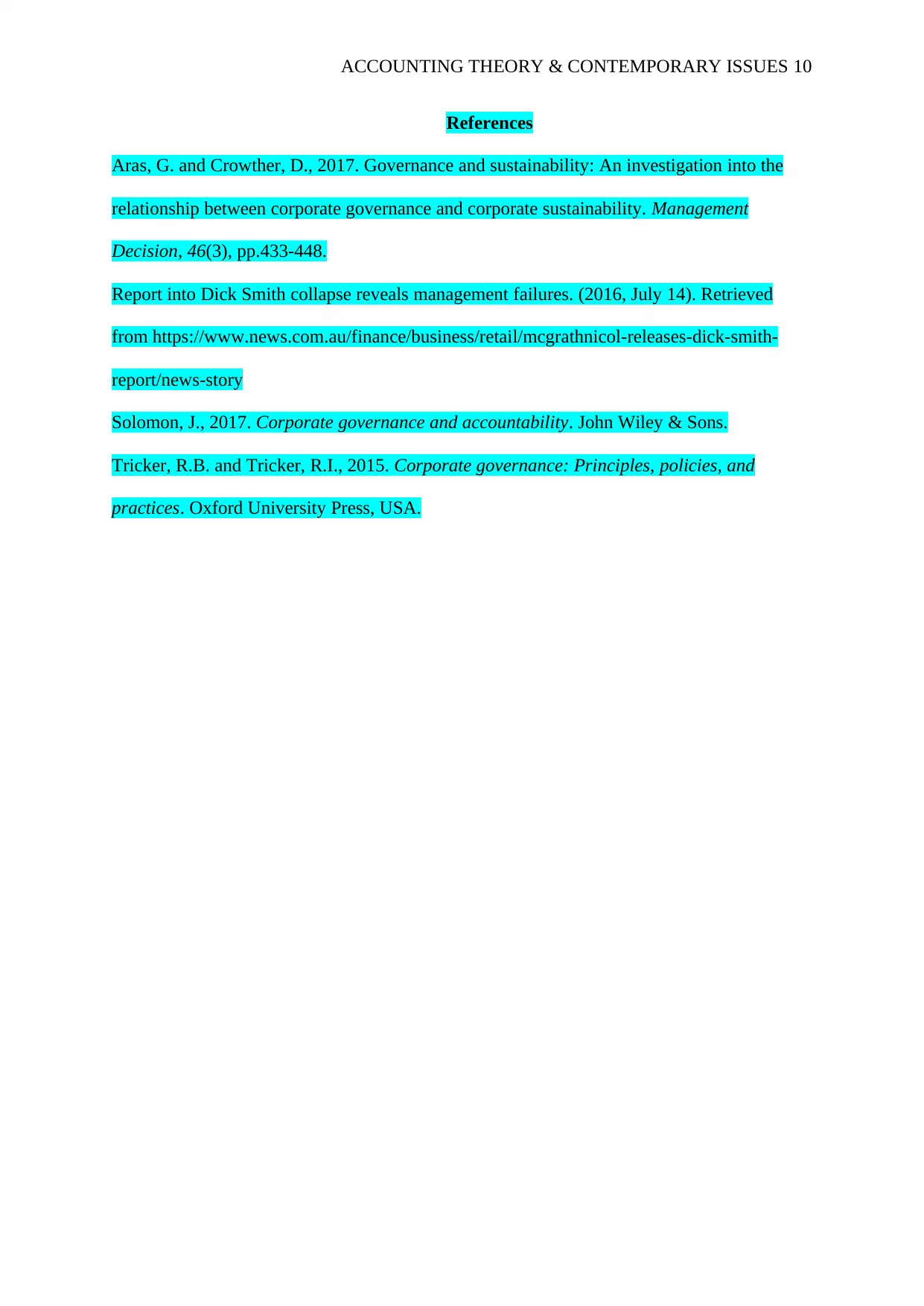
ACCOUNTING THEORY & CONTEMPORARY ISSUES 10
References
Aras, G. and Crowther, D., 2017. Governance and sustainability: An investigation into the
relationship between corporate governance and corporate sustainability. Management
Decision, 46(3), pp.433-448.
Report into Dick Smith collapse reveals management failures. (2016, July 14). Retrieved
from https://www.news.com.au/finance/business/retail/mcgrathnicol-releases-dick-smith-
report/news-story
Solomon, J., 2017. Corporate governance and accountability. John Wiley & Sons.
Tricker, R.B. and Tricker, R.I., 2015. Corporate governance: Principles, policies, and
practices. Oxford University Press, USA.
References
Aras, G. and Crowther, D., 2017. Governance and sustainability: An investigation into the
relationship between corporate governance and corporate sustainability. Management
Decision, 46(3), pp.433-448.
Report into Dick Smith collapse reveals management failures. (2016, July 14). Retrieved
from https://www.news.com.au/finance/business/retail/mcgrathnicol-releases-dick-smith-
report/news-story
Solomon, J., 2017. Corporate governance and accountability. John Wiley & Sons.
Tricker, R.B. and Tricker, R.I., 2015. Corporate governance: Principles, policies, and
practices. Oxford University Press, USA.
1 out of 10
Related Documents
Your All-in-One AI-Powered Toolkit for Academic Success.
+13062052269
info@desklib.com
Available 24*7 on WhatsApp / Email
![[object Object]](/_next/static/media/star-bottom.7253800d.svg)
Unlock your academic potential
© 2024 | Zucol Services PVT LTD | All rights reserved.




